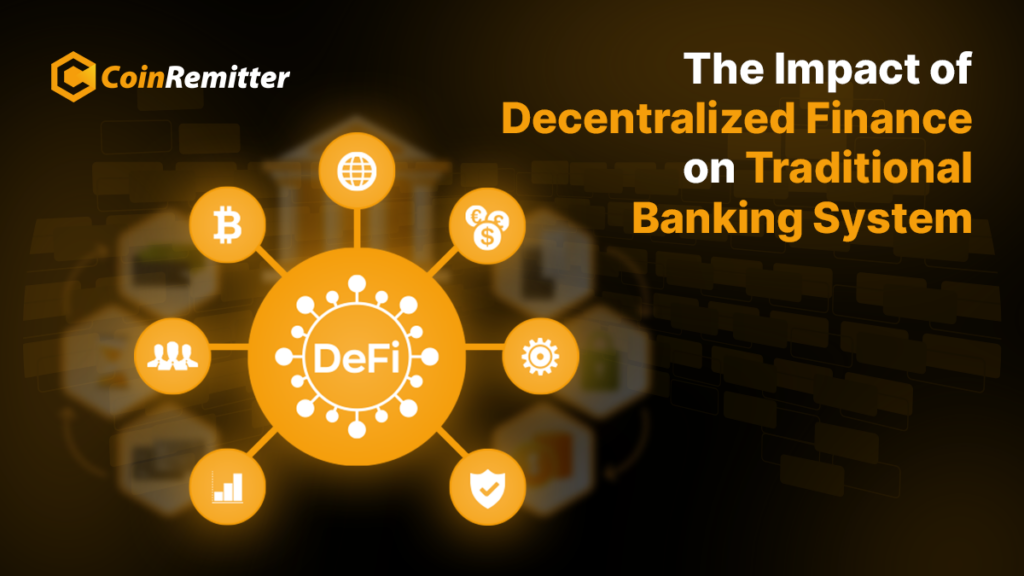The global financial system is witnessing a huge change with the emergence of technologies like DeFi (Decentralized Finance). Built upon blockchain technology, DeFi offers a decentralized option by enabling financial interactions without needing trust in a central authority, operating autonomously. However, its rise poses the biggest challenge to the future of the banking system and the financial markets worldwide. This blog will explain what DeFi is, its functionalities, and how it will impact the traditional structure of banking and finance.
Let’s start by understanding the challenges that the current traditional banking system is facing.
Challenges of the Traditional Banking System
- Technological advancements: The traditional banking systems are slow in adapting to new technological advancements. Their digital presence is limited to offering basic services like deposits, transfers, etc.
- Fees: one of the biggest issues is that banks often charge fees for services such as overdrafts, ATM withdrawals, and account maintenance, which can increase.
- Cyber attacks: With the rise in series of breaches in the past couple of years, security is one of the leading banking industry challenges today.
- Regulatory challenges: Banks must comply with evolving regulations such as anti-money laundering (AML) and data protection laws. Keeping up with these changes can be a time-consuming and costly process.
DeFi has the potential to address these challenges. Let’s understand what it is.
DeFi
DeFi (Decentralized Finance) refers to an emerging financial technology that operates outside traditional financial regulations. It’s an umbrella term for financial applications, platforms, and organizations that enable peer-to-peer transactions without intermediaries like banks or brokerage firms.
DeFi’s Core Principles
- Decentralization: DeFi applications operate on networks like Ethereum, using automated smart contracts for fast and secure transactions without depending on intermediaries.
- Interoperability: DeFi applications are built to work together, forming a connected financial ecosystem. This interoperability allows users to easily use various DeFi services and platforms in combination.
- Accessibility: There’s no need for a bank account to join DeFi. All you need is a digital wallet and internet access.
Now that we know what DeFi is and its core principles, let’s look at DeFi’s key components that play a key role in its functionality.
Key DeFi Components
- Blockchain Technology: The foundation of DeFi, blockchains provide a secure and transparent ledger for recording all transactions. Popular blockchains for DeFi include Ethereum.
- Smart Contracts: These are the building blocks of the DeFi network, enabling automated execution of agreements. They define the rules and logic governing transactions and interactions.
- Decentralized Exchanges (DEXs): Peer-to-peer marketplaces where users can trade cryptocurrencies directly without relying on centralized exchanges.
- Stablecoins: Stablecoins are cryptocurrencies designed to maintain a stable value by being pegged to assets like fiat currencies. They play an important role by providing price stability for transactions.
- Liquidity Pools: These are tokens’ pools locked in a smart contract to facilitate trading, lending, or other financial activities. Liquidity providers contribute funds to these pools in exchange for a share of transaction fees or interest.
How does DeFi impact traditional Banking?
Since it is built on blockchain, DeFi uses the technology to provide financial services directly to its users by eliminating the intermediaries. Let’s understand how it impacts the traditional banking system.
Easy Lending and Borrowing:
When it comes to providing loans to SMEs or new businesses, customers face difficulties in accessing them along with other services. Protocols like Aave can provide direct credit through DeFi channels. This can make it easy for customers to get instantly, rather than waiting for loan sanction.
Disintermediation:
DeFi platforms enable direct peer-to-peer transactions and financial services without the need any intermediaries or middlemen. This is in stark contrast with the banks where an individual is acting as an intermediary for facilitating transactions.
Yield Farming:
Within the DeFi exist strategies like yield farming where users can higher returns by simply lending their assets or providing liquidity on decentralized exchanges. These returns are often higher compared to bank returns.
Transparency:
Blockchain’s transparency allows anyone to verify transactions and smart contract codes, unlike traditional banking, which can be less clear about certain operations.
It is no secret that DeFi’s potential is vast and it can certainly impact the banks. But, is there a way where both DeFi and banks can coexist? Let’s find out.
How can DeFi benefit Banks?
The association between DeFi and traditional banks can open doors to many new opportunities and can be beneficial for both in the long term.
- DeFi can enhance financial services by using smart contracts. This will eliminate human error and manual validation. This will also make DeFi faster and more reliable than traditional methods.
- The biggest benefit of DeFi is that it operates digitally and can be accessible 24*7 from anywhere with the internet. This removes the limitation of market hours and traditional banking schedules, which makes it easy to do transactions at any time.
- DeFi protocols often include built-in risk management mechanisms, such as collateralization and algorithmic pricing. Banks can integrate these mechanisms into their risk management frameworks to mitigate risks associated with lending and investment activities.
Future Outlook
DeFi can impact the traditional finance and banking system in the future. The technology allows its user to have direct control over their assets and reduces their dependency on banks. As DeFi expands, it could lead to widespread adoption of decentralized financial systems, especially where traditional banking services are lacking.
Final Remark
The rise of DeFi represents an important change for the financial industry, especially the traditional banking system. It gives users direct control over their assets and transactions, reducing dependence on traditional banks. As DeFi access grows, we might see a big move towards decentralized finance.

